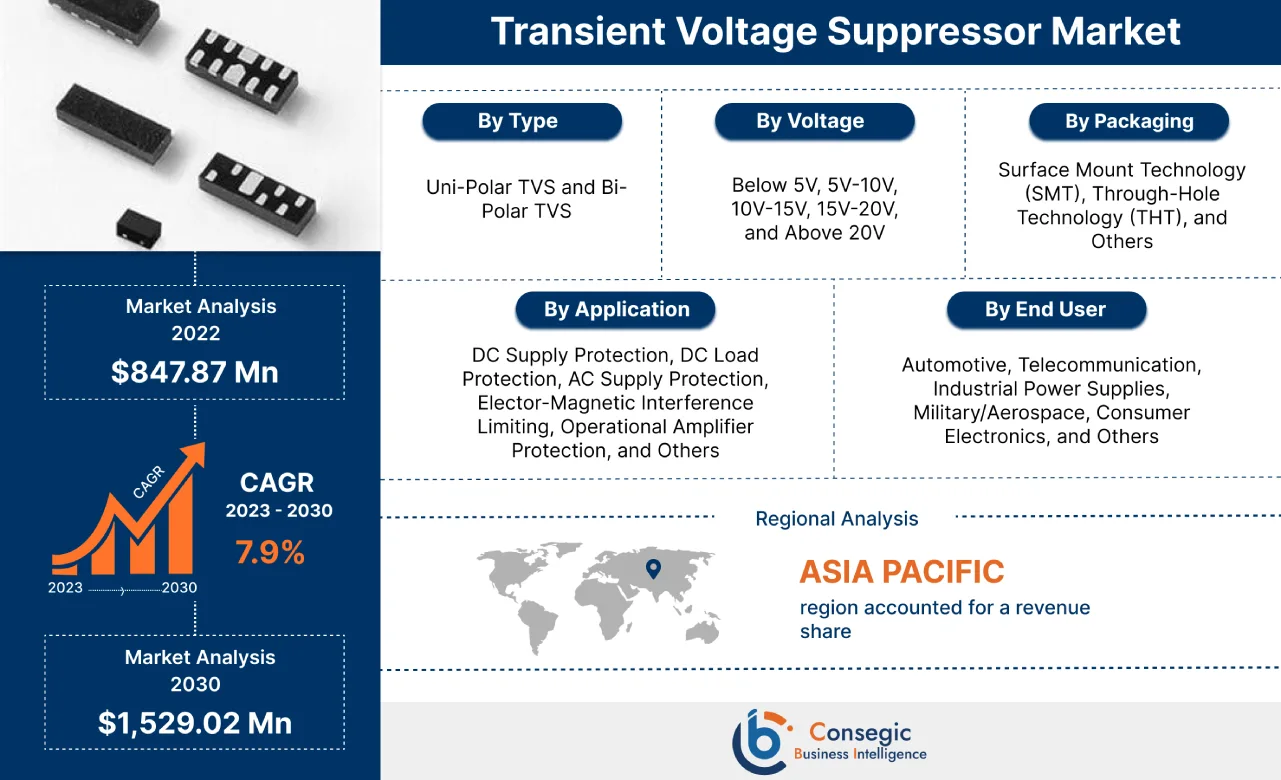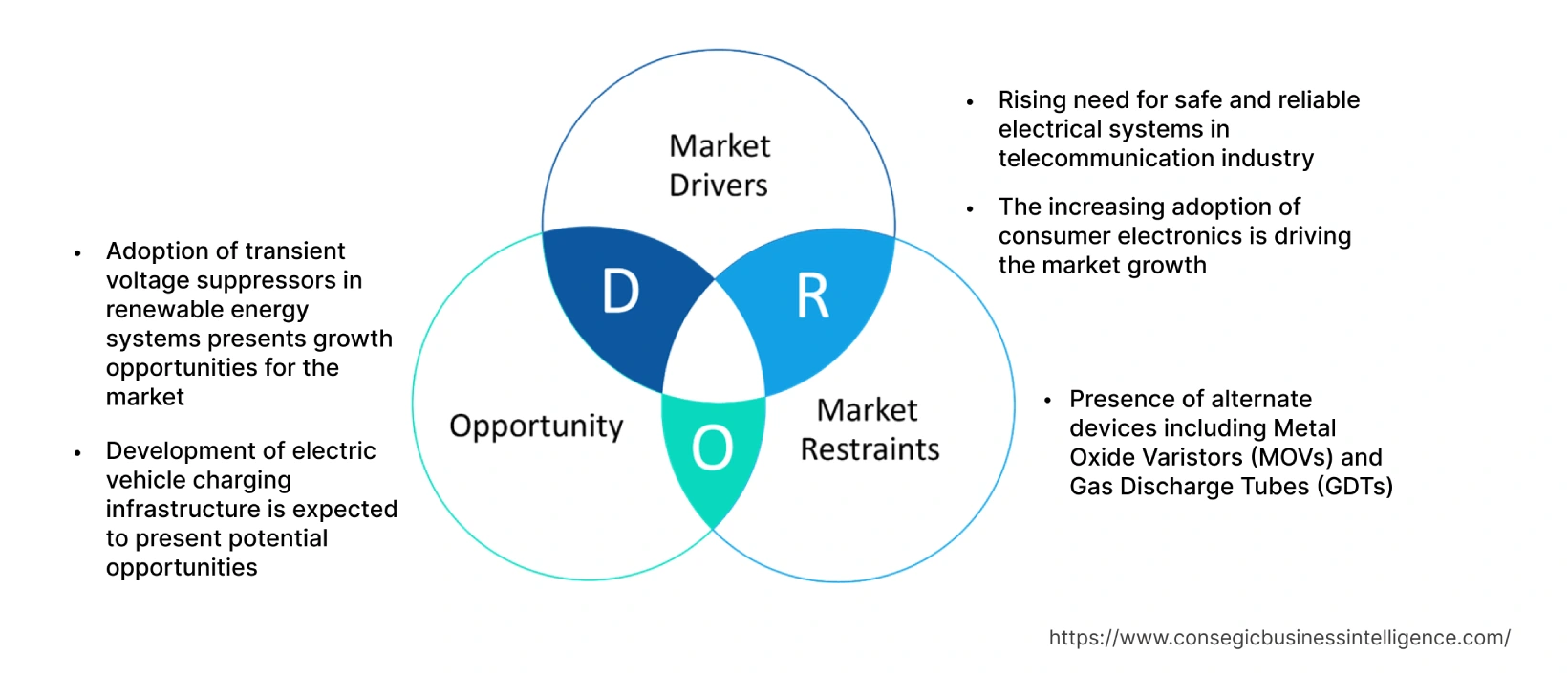Transient Voltage Suppressor Market Size :
Transient Voltage Suppressor Market size is estimated to reach over USD 1,529.02 Million by 2030 from a value of USD 847.87 Million in 2022, growing at a CAGR of 7.9% from 2023 to 2030.
Transient Voltage Suppressor Market Scope & Overview:
A transient voltage suppressor (TVS) is an electronic device designed to protect sensitive electronic components or circuits from voltage spikes or transients. Voltage spikes or transients occur due to lightning strikes, power surges, electrostatic discharge (ESD), or switching events in the electrical system. The primary function is to divert excess voltage away from the circuit and limit the voltage to a safe level. Consequently, as per the market trends analysis, they are used in a wide range of electronic systems and applications, including power supplies, communication systems, automotive electronics, industrial equipment, and consumer electronics.
Transient Voltage Suppressor Market Insights :
Transient Voltage Suppressor Market Dynamics - (DRO) :
Key Drivers :
Rising need for safe and reliable electrical systems in the telecommunication sector
The proliferation of high-speed communication technologies such as 5G, fiber optics, and high-speed data networks requires robust protection against voltage transients. TVS devices offer faster response times and higher surge handling capabilities to protect sensitive communication equipment and ensure reliable data transmission. For instance, in May 2023, Littelfuse, Inc. launched high-power TVS diodes called LTKAK2-L Series featuring a compact surface mount structure that protects DC and AC power supply to achieve high reliability. Consequently, as per the analysis of market trends, the increasing demand for high-speed communication is accelerating the transient voltage suppressor market growth.
The increasing adoption of consumer electronics is driving the market
The rising need for safe and reliable circuits in consumer electronics devices including smartphones, laptops, and IoT-enabled devices is driving the market. The increasing complexity and miniaturization of electronic systems raise the vulnerability of electrical systems to voltage transients. As a result, manufacturers are emphasizing product safety and reliability, thereby driving the demand for TVS devices to protect against voltage surges. For instance, in May 2023, ProTek Devices launched a TVS array called PVCOM24 for board-level circuit protection in mobile devices, batteries, industrial equipment, and USB fast-charging voltage buses. Thus, the analysis of market trends shows that the growing need for safe and reliable connections in electronic devices is propelling the growth of the transient voltage suppressor market.
Key Restraints :
The presence of alternate devices including Metal Oxide Varistors (MOVs) and Gas Discharge Tubes (GDTs)
The availability of alternate devices including Metal Oxide Varistors (MOVs) and Gas Discharge Tubes (GDTs) provides similar protection against voltage transients and is hindering the market. The high clamping efficiency and low steady-state power dissipation of MOVs offer considerable advantages in protecting the circuitry. Moreover, gas discharge tubes dissipate voltage transients through a contained plasma gas, thereby ensuring normal operation of the equipment. Therefore, the market trends analysis depicts that the presence of the aforementioned devices is restraining the transient voltage suppressor market growth.
Future Opportunities :
The adoption in renewable energy systems presents growth opportunities for the market
The integration of renewable energy systems that utilize solar and wind power into the electrical grid requires effective transient protection. Thus, transient voltage suppressors are expected to protect against voltage transients, helping to prevent damage to sensitive components and ensuring the reliability and longevity of renewable energy systems. Consequently, the analysis of market trends and the adoption of these suppressors for safeguarding critical infrastructure is expected to drive transient voltage suppressor market opportunities during the forecast period.
The development of electric vehicle charging infrastructure is expected to open new doors
EVs and charging stations are exposed to voltage transients and power fluctuations that require robust protection for the safety and reliability of the charging system components. Voltage imbalance due to constant charging of EVs increases the need for devices that protect against voltage fluctuations. Consequently, the market trends analysis shows that the growing adoption of electric vehicles among consumers is expected to drive transient voltage suppressor market opportunities during the forecast period.
Transient Voltage Suppressor Market Report Insights :
| Report Attributes | Report Details |
| Study Timeline | 2017-2030 |
| Market Size in 2030 | USD 1,529.02 Million |
| CAGR (2023-2030) | 7.9% |
| By Type | Uni-Polar TVS and Bi-Polar TVS |
| By Voltage | Below 5V, 5V-10V, 10V-15V, 15V-20V, and Above 20V |
| By Packaging | Surface Mount Technology (SMT), Through-Hole Technology (THT), and Others |
| By Application | DC Supply Protection, DC Load Protection, AC Supply Protection, Elector-Magnetic Interference Limiting, Operational Amplifier Protection, and Others |
| By End-User | Automotive, Telecommunication, Industrial Power Supplies, Military/Aerospace, Consumer Electronics, and Others |
| By Region | North America, Europe, Asia-Pacific, Latin America, and Middle East & Africa |
| Key Players | AVX Corporation, Bourns Inc., BrightKing Inc., Diodes Inc., Infineon Technologies AG, Littelfuse Inc., Microsemi Corporation, Nexperia, NXP Semiconductors N.V., ON Semiconductor Corporation, Panasonic Corporation, ProTek Devices, ROHM Semiconductor, Remcom |
Transient Voltage Suppressor Market Segmental Analysis :
By Type :
Based on the type, the market is bifurcated into Uni-Polar TVS and Bi-Polar TVS. The uni-polar segment accounted for the largest revenue in 2022 of the total transient voltage suppressor market share. The ability of uni-polar transient voltage devices to provide high surge current capabilities, low clamping voltage, and fast response times is driving the market. They are designed to handle transient voltage spikes in a single direction only. They are primarily used in low-voltage applications by diverting excessive energy away from the protected circuit. Therefore, applications such as consumer electronics, data lines, and telecommunications equipment are propelling the transient voltage suppressor market demand.
Bi-polar TVS is anticipated to emerge as the fastest-growing segment during the forecast period. They are designed to protect against voltage transients in both polarities. As a result, they are widely used in high-voltage applications including automotive electronics and power distribution systems. For instance, in March 2023, Diodes Incorporated launched a bi-directional TVS diode called D3V3Z1BD2CSP designed to offer protection from voltage surge and electrostatic discharge (ESD) strikes events. Thus, the analysis shows that the ability of these suppressors to protect in positive and negative directions is accelerating the transient voltage suppressor market trends.
By Voltage :
Based on the voltage, the market is segregated into Below 5V, 5V-10V, 10V-15V, 15V-20V, and Above 20V. The below 5V segment accounted for the largest revenue share in the year 2022. The increasing demand for low-voltage TVS diodes in applications such as mobile devices and power supplies is driving the segment. The devices under this segment are widely used for the protection of low-voltage electronic circuits, such as integrated circuits (ICs), microcontrollers, digital logic circuits, and low-power electronic devices.
The above 20V segment is anticipated to witness the fastest CAGR during the forecast period. The TVS devices under this segment are designed to protect sensitive electronics from damage due to electrical overstress (EOS), lightning, cable discharge events (CDE), and electrostatic discharge (ESD). As a result, these suppressors are employed to protect electronic systems operating at higher voltages, such as power distribution networks, industrial equipment, telecommunications infrastructure, and high-voltage power supplies. For instance, in March 2021, MDE Semiconductor launched TVS diodes with voltages of 33V to 190V designed for the protection of electronic systems from the destructive effects of electrostatic discharge, lightning, and inductive switching. Moreover, the ability of 20V and above TVS to provide fast response time, and low operating and clamping voltage is driving the transient voltage suppressor market trends.
By Packaging :
Based on the packaging, the market is divided into Surface Mount Technology (SMT), Through-Hole Technology (THT), and others. The surface mount technology accounted for the largest revenue of 43.37% in the year 2022 of the total transient voltage suppressor market share. It is the method of packaging and mounting electronic components directly onto the surface of Printed Circuit Boards (PCBs). As a result, they are widely used in various industries, including consumer electronics, telecommunications, automotive, and industrial equipment. For instance, in June 2022, Vishay launched three new 24 V surface-mount TVS called XClampR that offer high pulse power dissipation in telecom, automotive, and industrial applications. Moreover, the ability of surface mount TVS to provide high component density on the PCB is accelerating the transient voltage suppressor market demand.
Through-hole technology (THT) is expected to register the fastest CAGR during the forecast period. Through-hole technology refers to the method of mounting electronic components into the PCB board through holes. Through-hole technology TVS devices have leads that facilitate their insertion through holes into the PCB. Thus, the application of THT-TVS devices in automotive, aerospace, and power electronics is propelling the transient voltage suppressor market expansion.
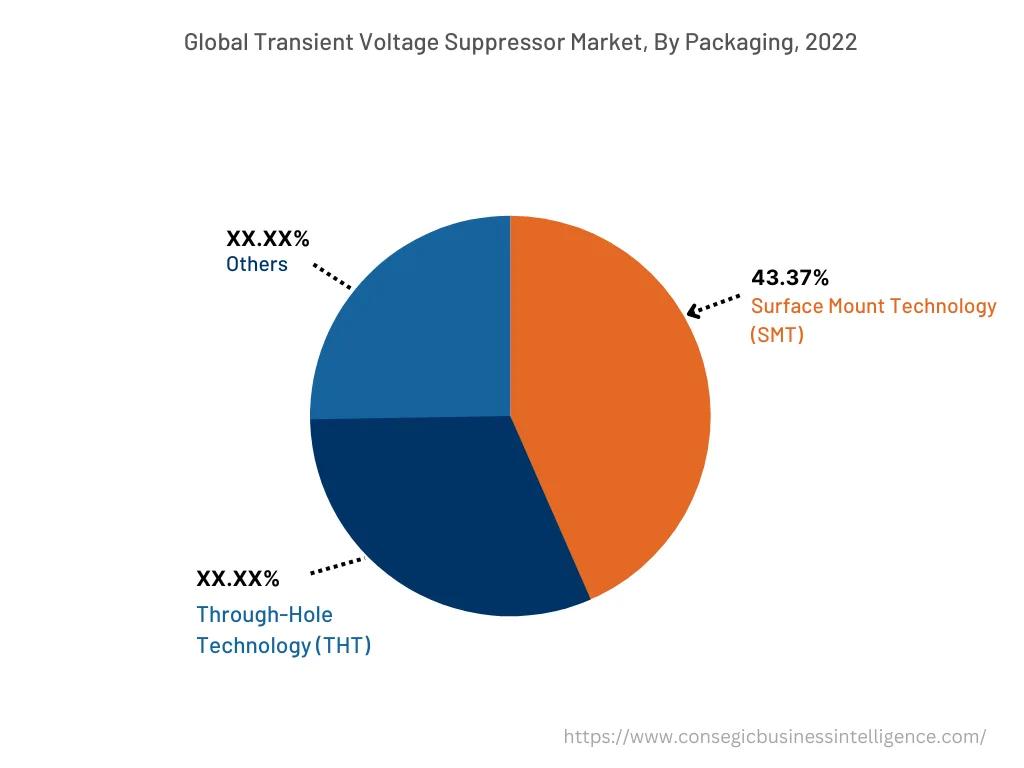
By Application :
Based on the application, the market is segregated into AC supply protection, DC load protection, DC supply protection, electromagnetic interference limiting, operational amplifier protection, and others. AC supply protection segment accounted for the largest revenue share in the year 2022. The increasing adoption of AC in residential power supply stations is driving the market. The adoption of AC in home appliances including HVAC equipment is driving the need for these devices for the protection of critical infrastructure. Moreover, AC supply protection is anticipated to emerge as the fastest-growing segment during the forecast period. TVS diodes for AC supply protection provide fast switching capabilities that allow semiconductor devices to respond to overvoltage.
By End-User :
Based on the end-user, the market is divided into automotive, telecommunication, industrial power supplies, military/aerospace, consumer electronics, and others. The industrial power supplies segment accounted for the largest revenue share in the year 2022. Industrial power supplies and equipment are susceptible to voltage transients as they involve the usage of heavy machinery, electrical systems, and power distribution networks. As a result, these suppressors are used to protect industrial power supplies, motor drives, and other industrial equipment from voltage surges to ensure the reliable operation of critical infrastructure, resulting in transient voltage suppressor market expansion.
The automotive sect is anticipated to register the fastest CAGR during the forecast period. Automotive vehicles are susceptible to electrostatic discharge (ESD), lightning, and switching loads in the electronic circuits. As a result, TVS devices are utilized in the automotive sector to protect various automotive electronics, including engine control units (ECUs), infotainment systems, and other electronic components from voltage transients. Therefore, the ability of these suppressors to address parameters such as power rating, stand-off voltage, breakdown voltage, and maximum breakdown voltage is accelerating the market.
By Region :
The regional segment includes North America, Europe, Asia Pacific, the Middle East and Africa, and Latin America.
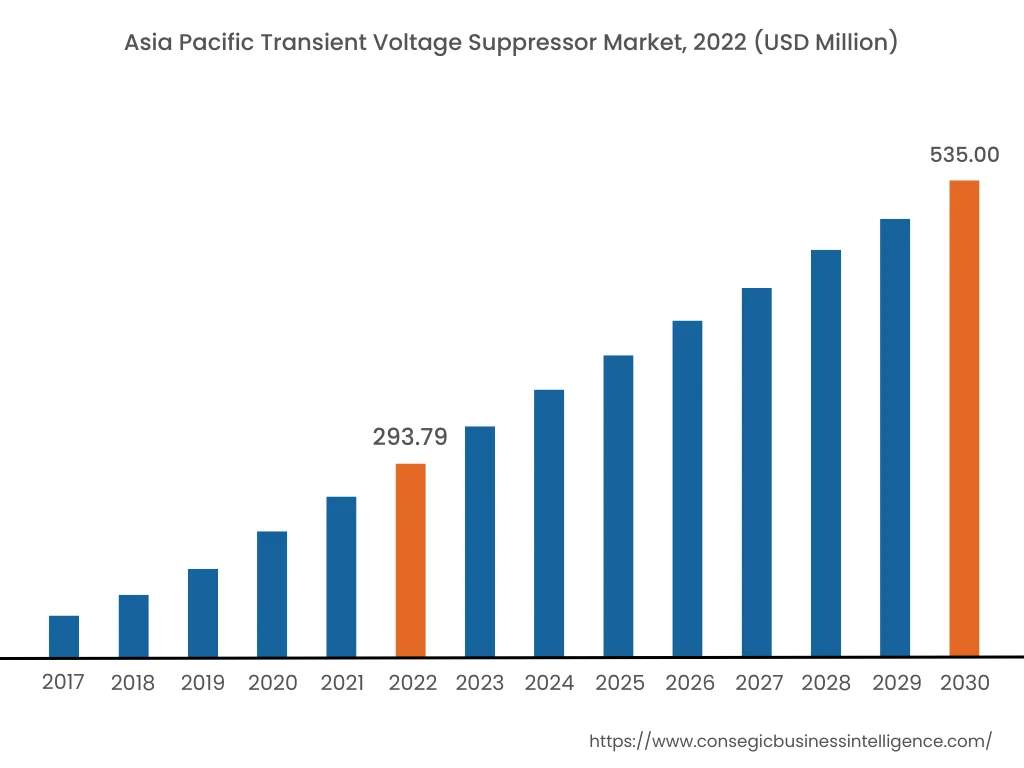
The Asia-Pacific region accounted for a revenue share of USD 293.79 million in 2022 and is expected to reach USD 535.00 million in 2030, registering a CAGR of 8.1% during the forecast period. Additionally, in the region, China accounted for the largest revenue share of 27.38% in the year 2022. As per the transient voltage suppressor market analysis, the growing automotive industry in the Asia-Pacific region is driving the demand for these suppressors for the protection of critical components. TVS devices are deployed in the automotive industry to protect electronic components and systems in vehicles, including ECUs, infotainment systems, ADAS (Advanced Driver Assistance Systems), and electric powertrains. Moreover, the growing adoption of electric vehicles among consumers is accelerating the growth of the market.
Additionally, the Asia-Pacific region is anticipated to emerge as the fastest-growing segment during the forecast period. The demand for smartphones, tablets, wearable devices, home appliances, and other consumer electronics is presently fuelling the need for TVS devices to protect devices from voltage transients, ensuring reliable operation and longevity. For instance, in February 2022, Toshiba introduced a new low-capacitance TVS diode for high-frequency antennas of IoT devices to protect devices against noise and static electricity while suppressing signal deterioration. Therefore, the growing automotive industry in the Asia-Pacific region coupled with the increasing adoption of consumer electronics devices is driving the growth of the regional transient voltage suppressor market.
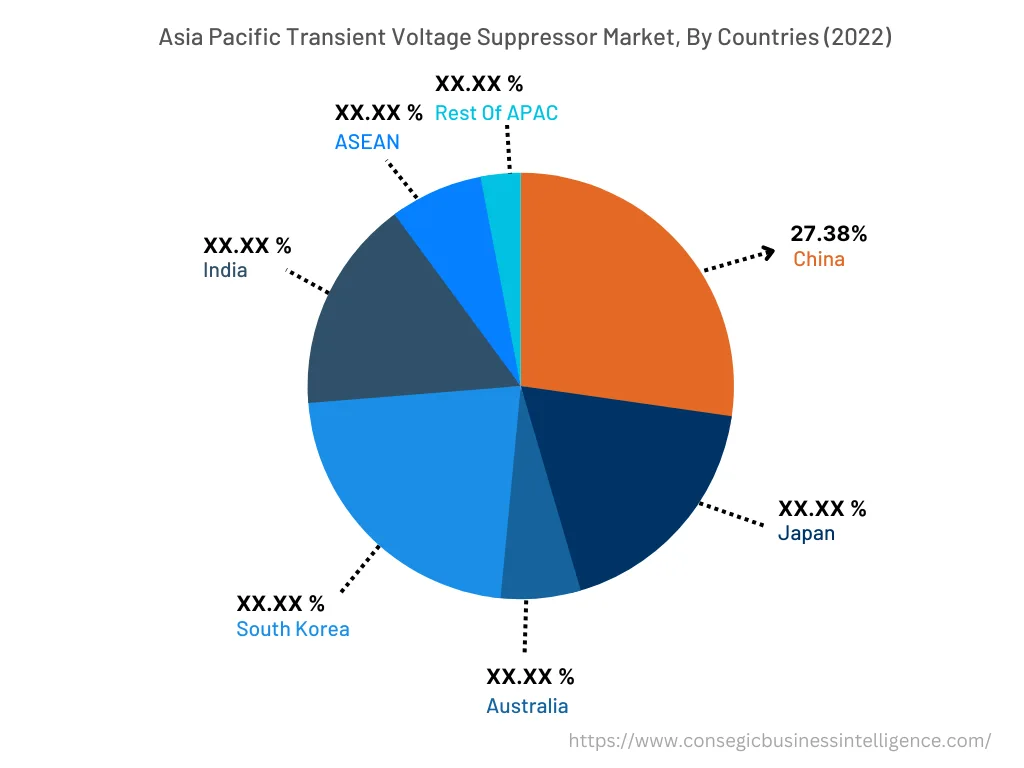
Top Key Players & Market Share Insights:
The transient voltage suppressor market is characterized by the presence of major players providing transient voltage suppressors for the protection of electronic devices. Key players operating in the market are adopting several business strategies including research and development (R&D), product innovation, and application launches that accelerate the growth of the transient voltage suppressor market. Key players in the transient voltage suppressor industry include-
- KYOCERA AVX Components Corporation
- Bourns Inc.
- On Semiconductor Corporation
- Panasonic Corporation
- ProTek Devices
- ROHM Semiconductor
- Remcom
- Diodes Inc.
- Infineon Technologies AG
- Littelfuse Inc.
- Microsemi Corporation
- Nexperia
- NXP Semiconductors N.V.
Recent Industry Developments :
- In May 2023, TDK Electronics launched compact TVS diodes compatible with USB-C ports providing low clamping voltage for ESD protection.
- In September 2022, Bourns, Inc. launched a bidirectional power transient voltage suppressor (PTVS) diode called PTVS20-015C-TH designed for high-power DC line protection applications.
Key Questions Answered in the Report
What is Transient Voltage Suppressor? +
Transient voltage suppressors are the devices that provide protection to the electronic devices due to fluctuations on voltage. Transient voltage suppressors divers the excess voltage away from the protected circuit.
What specific segmentation details are covered in the transient voltage suppressor report, and how is the dominating segment impacting the market growth? +
By type segment has witnessed uni-polar TVS as the dominating segment in the year 2022, due to its ability to provide high surge current capabilities, low clamping voltage, and fast response times.
What specific segmentation details are covered in the transient voltage suppressor market report, and how is the fastest segment anticipated to impact the market growth? +
By end-user segment has witnessed automotive as the fastest-growing segment during the forecast period due to its ability to protect electronic circuits from electrostatic discharge (ESD), lightning, and switching loads.
Which region/country is anticipated to witness the highest CAGR during the forecast period, 2023-2030? +
Asia Pacific is expected to register fastest CAGR growth during the forecast period due to the increasing adoption of IoT-enabled devices in the region.
